Ilia Kulikov
NaturalReasoning: Reasoning in the Wild with 2.8M Challenging Questions
Feb 18, 2025Abstract:Scaling reasoning capabilities beyond traditional domains such as math and coding is hindered by the lack of diverse and high-quality questions. To overcome this limitation, we introduce a scalable approach for generating diverse and challenging reasoning questions, accompanied by reference answers. We present NaturalReasoning, a comprehensive dataset comprising 2.8 million questions that span multiple domains, including STEM fields (e.g., Physics, Computer Science), Economics, Social Sciences, and more. We demonstrate the utility of the questions in NaturalReasoning through knowledge distillation experiments which show that NaturalReasoning can effectively elicit and transfer reasoning capabilities from a strong teacher model. Furthermore, we demonstrate that NaturalReasoning is also effective for unsupervised self-training using external reward models or self-rewarding.
LLM Pretraining with Continuous Concepts
Feb 12, 2025Abstract:Next token prediction has been the standard training objective used in large language model pretraining. Representations are learned as a result of optimizing for token-level perplexity. We propose Continuous Concept Mixing (CoCoMix), a novel pretraining framework that combines discrete next token prediction with continuous concepts. Specifically, CoCoMix predicts continuous concepts learned from a pretrained sparse autoencoder and mixes them into the model's hidden state by interleaving with token hidden representations. Through experiments on multiple benchmarks, including language modeling and downstream reasoning tasks, we show that CoCoMix is more sample efficient and consistently outperforms standard next token prediction, knowledge distillation and inserting pause tokens. We find that combining both concept learning and interleaving in an end-to-end framework is critical to performance gains. Furthermore, CoCoMix enhances interpretability and steerability by allowing direct inspection and modification of the predicted concept, offering a transparent way to guide the model's internal reasoning process.
Diverse Preference Optimization
Jan 31, 2025



Abstract:Post-training of language models, either through reinforcement learning, preference optimization or supervised finetuning, tends to sharpen the output probability distribution and reduce the diversity of generated responses. This is particularly a problem for creative generative tasks where varied responses are desired. In this work we introduce Diverse Preference Optimization (DivPO), an optimization method which learns to generate much more diverse responses than standard pipelines, while maintaining the quality of the generations. In DivPO, preference pairs are selected by first considering a pool of responses, and a measure of diversity among them, and selecting chosen examples as being more rare but high quality, while rejected examples are more common, but low quality. DivPO results in generating 45.6% more diverse persona attributes, and an 74.6% increase in story diversity, while maintaining similar win rates as standard baselines.
Adaptive Decoding via Latent Preference Optimization
Nov 14, 2024



Abstract:During language model decoding, it is known that using higher temperature sampling gives more creative responses, while lower temperatures are more factually accurate. However, such models are commonly applied to general instruction following, which involves both creative and fact seeking tasks, using a single fixed temperature across all examples and tokens. In this work, we introduce Adaptive Decoding, a layer added to the model to select the sampling temperature dynamically at inference time, at either the token or example level, in order to optimize performance. To learn its parameters we introduce Latent Preference Optimization (LPO) a general approach to train discrete latent variables such as choices of temperature. Our method outperforms all fixed decoding temperatures across a range of tasks that require different temperatures, including UltraFeedback, Creative Story Writing, and GSM8K.
Self-Taught Evaluators
Aug 05, 2024
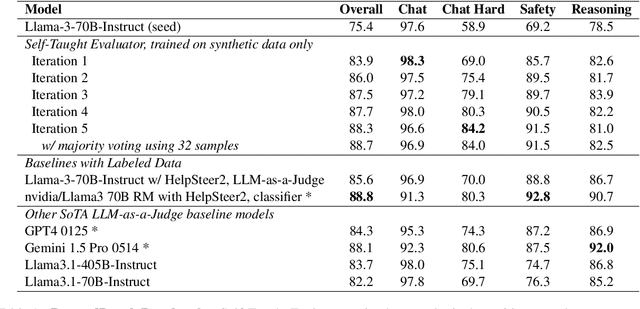
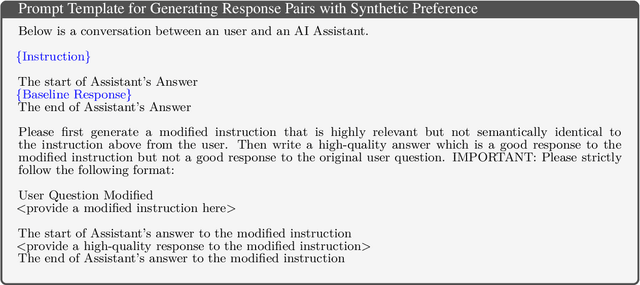
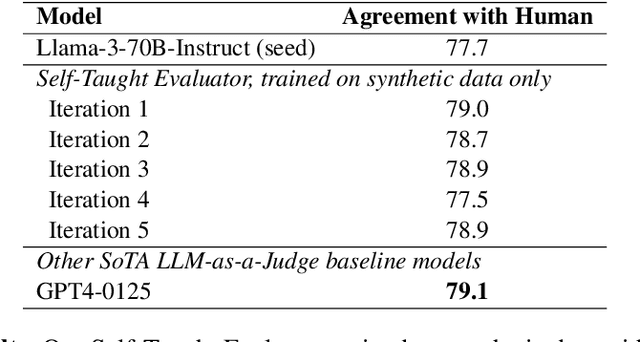
Abstract:Model-based evaluation is at the heart of successful model development -- as a reward model for training, and as a replacement for human evaluation. To train such evaluators, the standard approach is to collect a large amount of human preference judgments over model responses, which is costly and the data becomes stale as models improve. In this work, we present an approach that aims to im-prove evaluators without human annotations, using synthetic training data only. Starting from unlabeled instructions, our iterative self-improvement scheme generates contrasting model outputs and trains an LLM-as-a-Judge to produce reasoning traces and final judgments, repeating this training at each new iteration using the improved predictions. Without any labeled preference data, our Self-Taught Evaluator can improve a strong LLM (Llama3-70B-Instruct) from 75.4 to 88.3 (88.7 with majority vote) on RewardBench. This outperforms commonly used LLM judges such as GPT-4 and matches the performance of the top-performing reward models trained with labeled examples.
Distilling System 2 into System 1
Jul 09, 2024



Abstract:Large language models (LLMs) can spend extra compute during inference to generate intermediate thoughts, which helps to produce better final responses. Since Chain-of-Thought (Wei et al., 2022), many such System 2 techniques have been proposed such as Rephrase and Respond (Deng et al., 2023a), System 2 Attention (Weston and Sukhbaatar, 2023) and Branch-Solve-Merge (Saha et al., 2023). In this work we investigate self-supervised methods to ``compile'' (distill) higher quality outputs from System 2 techniques back into LLM generations without intermediate reasoning token sequences, as this reasoning has been distilled into System 1. We show that several such techniques can be successfully distilled, resulting in improved results compared to the original System 1 performance, and with less inference cost than System 2. We posit that such System 2 distillation will be an important feature of future continually learning AI systems, enabling them to focus System 2 capabilities on the reasoning tasks that they cannot yet do well.
Investigating Decoder-only Large Language Models for Speech-to-text Translation
Jul 03, 2024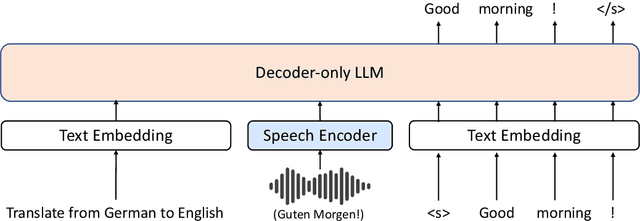

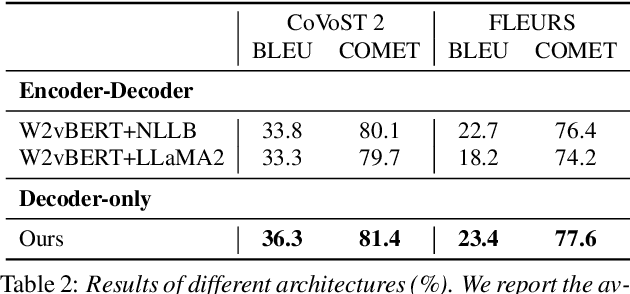
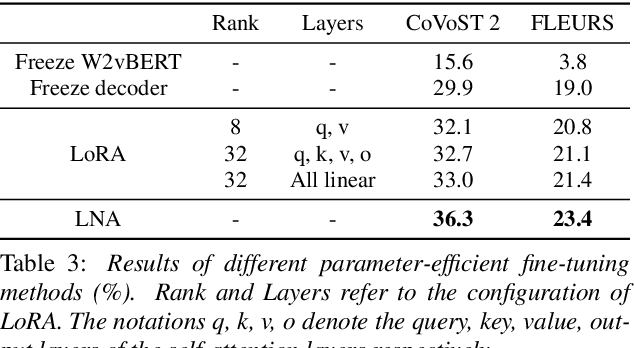
Abstract:Large language models (LLMs), known for their exceptional reasoning capabilities, generalizability, and fluency across diverse domains, present a promising avenue for enhancing speech-related tasks. In this paper, we focus on integrating decoder-only LLMs to the task of speech-to-text translation (S2TT). We propose a decoder-only architecture that enables the LLM to directly consume the encoded speech representation and generate the text translation. Additionally, we investigate the effects of different parameter-efficient fine-tuning techniques and task formulation. Our model achieves state-of-the-art performance on CoVoST 2 and FLEURS among models trained without proprietary data. We also conduct analyses to validate the design choices of our proposed model and bring insights to the integration of LLMs to S2TT.
Following Length Constraints in Instructions
Jun 25, 2024



Abstract:Aligned instruction following models can better fulfill user requests than their unaligned counterparts. However, it has been shown that there is a length bias in evaluation of such models, and that training algorithms tend to exploit this bias by learning longer responses. In this work we show how to train models that can be controlled at inference time with instructions containing desired length constraints. Such models are superior in length instructed evaluations, outperforming standard instruction following models such as GPT4, Llama 3 and Mixtral.
From Decoding to Meta-Generation: Inference-time Algorithms for Large Language Models
Jun 24, 2024Abstract:One of the most striking findings in modern research on large language models (LLMs) is that scaling up compute during training leads to better results. However, less attention has been given to the benefits of scaling compute during inference. This survey focuses on these inference-time approaches. We explore three areas under a unified mathematical formalism: token-level generation algorithms, meta-generation algorithms, and efficient generation. Token-level generation algorithms, often called decoding algorithms, operate by sampling a single token at a time or constructing a token-level search space and then selecting an output. These methods typically assume access to a language model's logits, next-token distributions, or probability scores. Meta-generation algorithms work on partial or full sequences, incorporating domain knowledge, enabling backtracking, and integrating external information. Efficient generation methods aim to reduce token costs and improve the speed of generation. Our survey unifies perspectives from three research communities: traditional natural language processing, modern LLMs, and machine learning systems.
Textless Acoustic Model with Self-Supervised Distillation for Noise-Robust Expressive Speech-to-Speech Translation
Jun 04, 2024Abstract:In this paper, we propose a textless acoustic model with a self-supervised distillation strategy for noise-robust expressive speech-to-speech translation (S2ST). Recently proposed expressive S2ST systems have achieved impressive expressivity preservation performances by cascading unit-to-speech (U2S) generator to the speech-to-unit translation model. However, these systems are vulnerable to the presence of noise in input speech, which is an assumption in real-world translation scenarios. To address this limitation, we propose a U2S generator that incorporates a distillation with no label (DINO) self-supervised training strategy into it's pretraining process. Because the proposed method captures noise-agnostic expressivity representation, it can generate qualified speech even in noisy environment. Objective and subjective evaluation results verified that the proposed method significantly improved the performance of the expressive S2ST system in noisy environments while maintaining competitive performance in clean environments.
 Add to Chrome
Add to Chrome Add to Firefox
Add to Firefox Add to Edge
Add to Edge